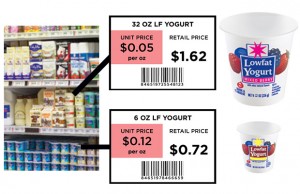If you are conscious of your grocery budget, you’re probably taking steps toward savings, like shopping for sales, using coupons, and comparison-shopping. Comparison-shopping for different prices on similar products is a great way to save money – if it’s done in a way that truly gives you an apples-to-apples comparison. Unfortunately, sometimes when we compare two items’ purchase prices, it is more of an apples-to-oranges comparison…unless you use unit pricing.
Unit pricing tells you how much you’ll pay per ounce or other unit of measurement – rather than the amount you’re paying for an entire package. A product’s unit price is usually listed somewhere on the grocery shelves next to or near the price of the product itself. Since packages come in various sizes, you need to think in terms of “price per ounce” rather than price per container. More often than not, the larger package (bulk) will be the better  “per ounce” price. The yogurt in this example shows that an ounce of yogurt in the larger container is only 5 cents an ounce whereas the single serving container costs more than twice that at 12 cents an ounce. The larger package does not always have the cheaper per ounce price, however, so check every time.
“per ounce” price. The yogurt in this example shows that an ounce of yogurt in the larger container is only 5 cents an ounce whereas the single serving container costs more than twice that at 12 cents an ounce. The larger package does not always have the cheaper per ounce price, however, so check every time.
If you’re concerned about having more product than you need, remember that freezing food is a great way to make it last longer. Refer to our fact sheet on freezing basics to learn how to freeze your food properly to stretch your food dollars even further.
Most consumers, after learning how to use unit pricing, report that this is a skill that they intend to adopt to make sure they’re getting the best buys. If you’ve never used unit pricing when shopping and need to learn how, take a look at this helpful description from USDA’s MyPlate.
If you are a parent, this is a wonderful skill to teach your children next time they are shopping with you. Sharing this basic concept will go a long way in making them smart consumers. Comparing unit prices is also effective when shopping for household cleaning supplies, toiletries, and other items.

